Bearded dragons are one of the most beloved types of pet lizards, and their popularity continues to explode in the US and elsewhere. Beardies are special. They are fun, friendly, and fascinating to observe.
Bearded dragons are known for bonding with their caretakers in ways that many other reptiles usually do not. A well-cared-for dragon will often show fondness for its owner, responding to the sound of his or her voice and responding positively to physical affection.
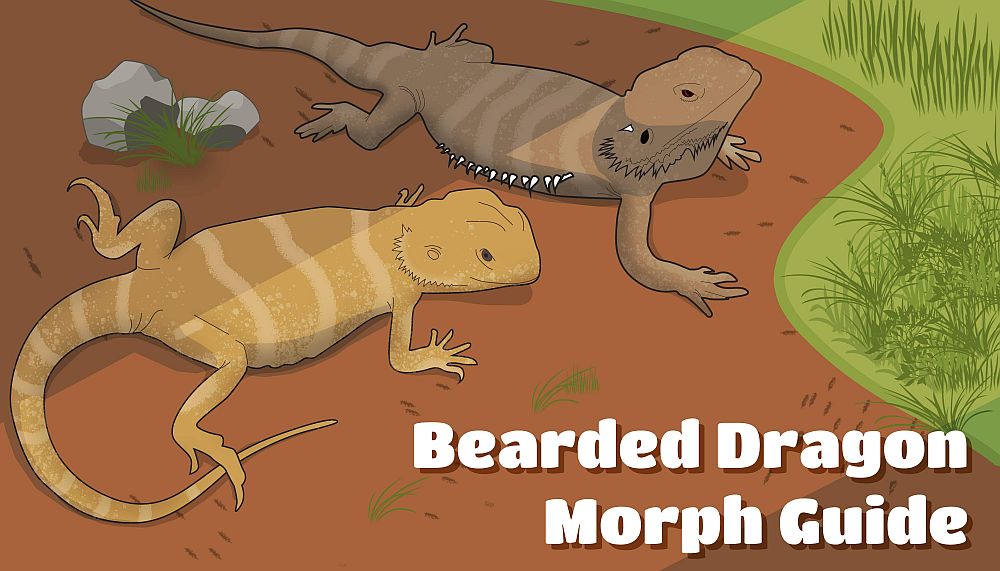
If you’ve thought about bringing a lizard into your life (or you’re just curious about them), you’ve probably heard about different “bearded dragon morphs”…but what is a morph?
Morph is a term used to describe different physical characteristics.
Some bearded dragon breeders may refer to color and pattern variations as morph types. However, a true morph is a particular genetic mutation known to cause certain traits. This is different than colors and patterns that can occur across different genetic morphs.
A bearded dragon can display a combination of morphs and other physical features.
Quick Navigation
Bearded Dragon Breeding Terminology
Genetics in general is a complicated area of study. Knowing a few basic terms can help you navigate the more technical information you may come across as you read and research about bearded dragon morphs.
- Het: Het is short for “heterozygous.” This just means that an animal carries a certain trait but does not physically display it.
- Selective Breeding: Selective breeding is when two particular types of bearded dragon are mated in an attempt to create specific outcomes, such as certain colors, patterns or other features.
- Proven: In the world of bearded dragon breeding, the term “proven” refers to an animal that has been successfully bred.
- Recessive Traits: These are traits that come from a recessive gene. For a recessive trait to present visually, it must be passed down from both parents.
- Dominant Traits: A dominant trait will be displayed in offspring even if only one parent carries it.
- Co-Dominant Traits: When offspring shows multiple dominant traits, they are considered to be co-dominant.
- Leucism: Leucistic animals produce very little melanin, making them appear much lighter in color than usual. Witblits, zeros, and hypos are all leucistic. Leucism is different than albinism, which causes an animal to produce no melanin at all.
Color Variations in Bearded Dragons
Bearded dragons can display a variety of colors. The intensity of patterns and colors in bearded dragons can be a determining factor in how much they are worth on the pet market.
While a beardie’s morph variety can affect its coloring, the color of a bearded dragon alone is not considered a morph. These colors and various combination of them can be found within many morph varieties.
- Red – Red varieties you may see include red, blood red, and ruby red bearded dragons.
- Orange – Sunburst and tangerine are common names for varieties of orange bearded dragons that are regularly seen from breeders and in pet stores.
- Brown and Tan – The most common colors for bearded dragons to display are sandy browns, beiges, and muted tans.
- Yellow – Yellow colored dragons are sometimes called sandfire, citrus, lemon, and gold by breeders.
- White and Silver – Some of the leucistic morphs come in shades of white, off-white, silver, and gray.
Types of Bearded Dragon Morphs
The following list outlines the true morph types for bearded dragons.
Classic or Normal Bearded Dragons
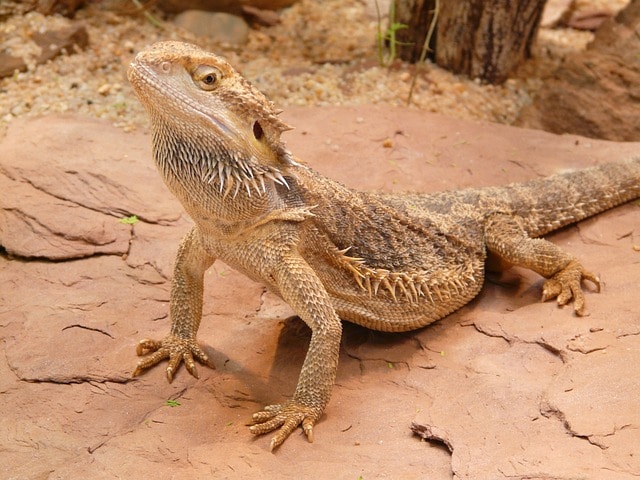
This type of bearded dragon most closely resembles the ones found in the wild. They have spikes running down their back and sides of their body. They also have the signature triangular head and spiky beard. Most often, these come in shades of tan or brown. However, they can display a variety of colors including red, yellow, and orange.
Hypomelanistic Bearded Dragons

Hypomelanistic, or “hypo” bearded dragons display lighter coloring than other types. Melanin is pigment that makes the skin of an animal appear darker. Hypomelanism is a recessive trait that causes a bearded dragon to make less melanin, resulting in lighter coloration. Aside from their light coloring, another signature feature of hypomelanistic beardies is that they have clear nails.
You may see hypos referred to as “pastels” on occasion.
Some types of melanistic morphs you may see are:
- Red Hypomelanistic
- Blood Hypo Orange
- Yellow Hypo
- Hypo Red Crawley
- Red Het Hypomelanistic
- Hypo Het Translucent
- English Belgium Hypo
- Hypo Yellow
- Hypo Snow
Leatherback Bearded Dragons
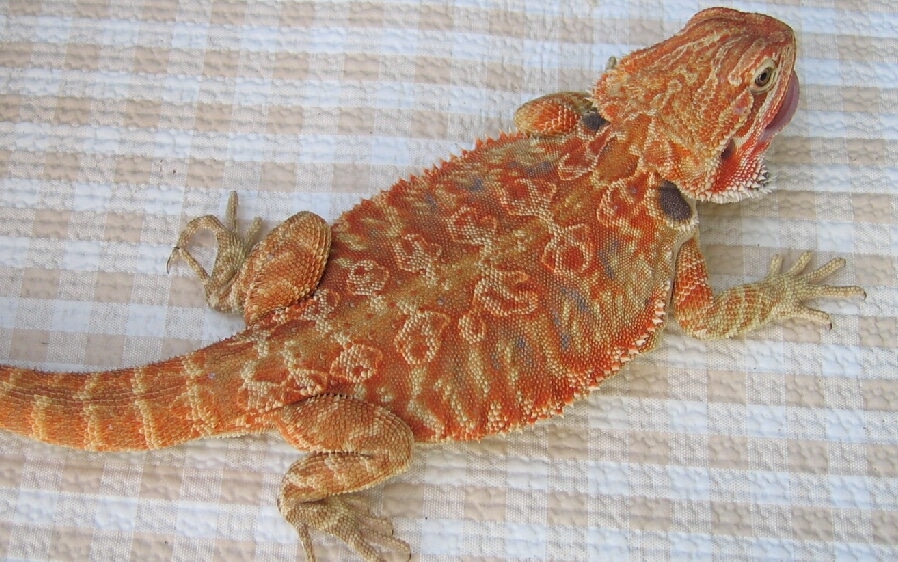
Leatherback bearded dragons are distinguished by their smooth, spikeless backs. They do still have spikes around their heads and along the sides of their bodies like other beardies, though. The absence of spikes on their backs can cause their coloring to appear more vivid.
Of course, just as with any morph, there will be some variations. Some leatherbacks do have some small spikes on their backs, though they are usually little more than enlarged scales rather than true spikes.
You may come across the terms “American Leatherback” and “Italian Leatherback,” both of which are obsolete since the leatherback mutations found in both Italy and the United States are considered to be indistinguishable.
Leatherbacks are more rare than classic and hypomelanistic morphs, making them more expensive to purchase.
Some popular leatherback varieties include:
- Hypo Leatherback
- Het Hypomelanistic Leatherback
- Purple Paradox Leatherback
- Hypo Translucent Leatherback Dunner
Micro Scale Bearded Dragons
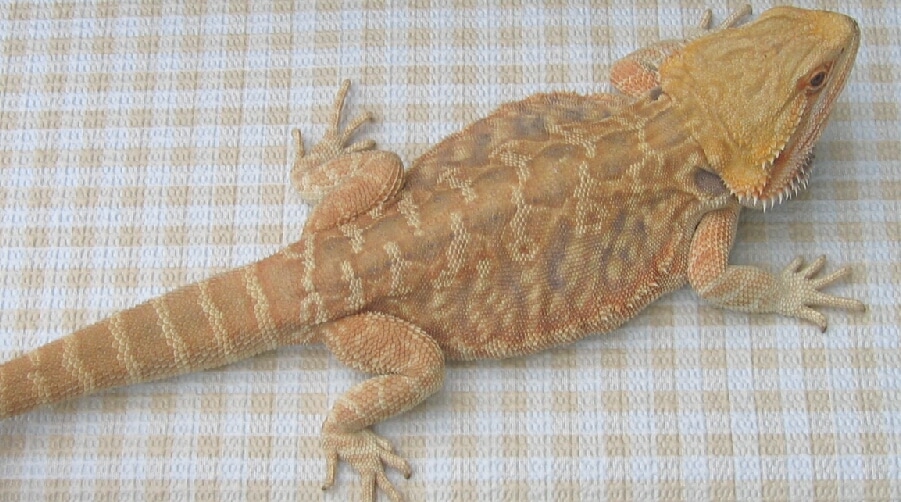
The micro scale morph comes from combining the co-dominant leatherback mutation with the recessive leatherback mutation. The result is a beardie resembling a leatherback but with fewer spikes. They usually do not have any spikes on their beard or sides of the body, and the spikes on the back of their head are smaller than normal
Silkback Bearded Dragons
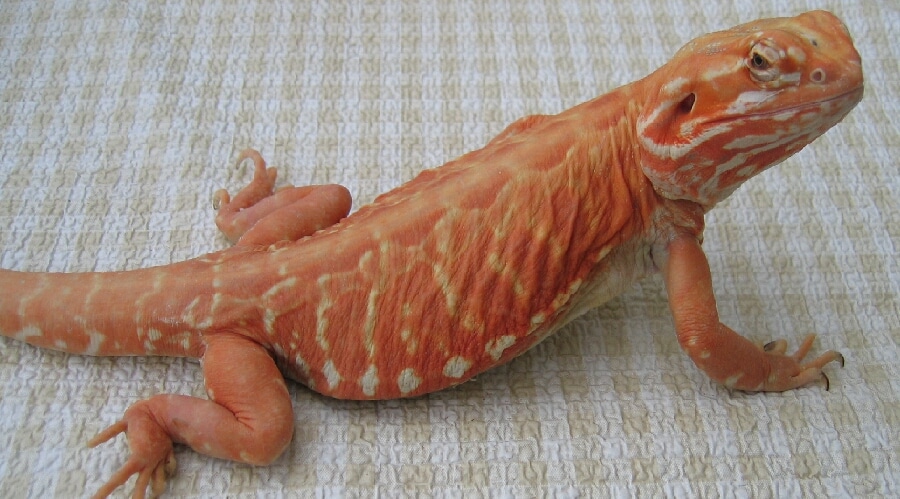
Silkback morphs do not have any spikes or scales on their bodies, which makes them one of the most unique bearded dragon types. The lack of spikes and scales makes their skin look and feel soft and silky, hence the name. While these types of bearded dragons are certainly intriguing and attractive, it’s important to note that they can be more difficult to care for than other varieties.
Not having any spikes or scales leaves these lizards with skin that is vulnerable to damage. Because of this, some breeders will not produce silkback varieties, believing it to be unethical.
If you do end up with a silkback bearded dragon morph, it’s important to take proper care of it. These soft and sensitive beardies will need to be bathed and moisturized regularly to promote healthy circulation and to aid proper shedding of old skin. It’s extremely important to house silkbacks alone. Since they are so vulnerable, even a non-aggressive lizard in the same tank could inadvertently cause serious injuries with its nails or spikes.
Additionally, great care should be taken when selecting objects to place in a silkback’s enclosure. Rocks, branches, and other items that might normally be fine in a beardie habitat could seriously hurt a silky.
Translucent Bearded Dragons
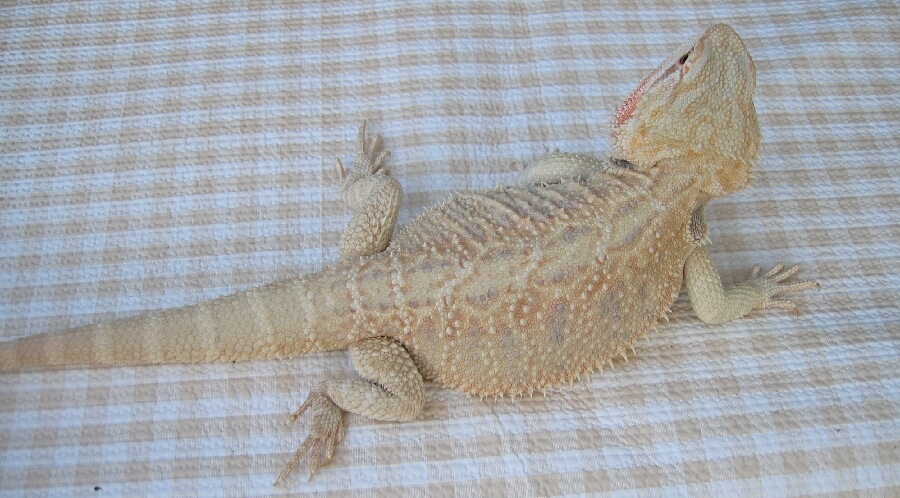
Translucent bearded dragons, sometimes called “trans” morphs, get their name from their somewhat see-through appearance. This is the result of a recessive trait. Trans babies have bellies that appear bluish in color, and they may display a blue tint in other areas as well (particularly above the eyes).
As their skin grows thicker in adulthood, most translucent beardies lose the bluish coloration, though some do retain the blue throughout their lifetime.
Myth: Trans Morphs are Prone to Health Problems – You may hear or read that translucent bearded dragons are more susceptible to health problems than other morphs. This has never been proven to be true, and people have been successfully breeding healthy trans morphs for many years now.
Another distinguishing characteristic of this morph type is solid black eye coloring. Keep in mind, though, that not every trans morph will have solid black eyes. In fact, translucent morphs may experience changes in the way their eyes look as they grow. A baby with solid eyes may develop more typical looking eye coloration as it ages.
Some translucent morphs have even been known to change back and forth from one kind of eye coloration to another within their lifetime.
Some breeders use the term “partial trans” for translucent morphs that display atypical features such as non-solid colored eyes. However, this is not really accurate. There is no partial translucent morph. There are only trans morphs with typical and atypical features.
Some varieties of the translucent morph you may see include:
- Red and Orange Hypo Translucent
- Hypo Translucent Genetic Stripe and Leatherback Genetic Stripe
- Rally Red Trans
- Citrus Tiger Hypo Translucent
- Dark Translucent
- Hypo Het Translucent
- Polar Translucent
- Belgium Translucent
Dunner Bearded Dragons
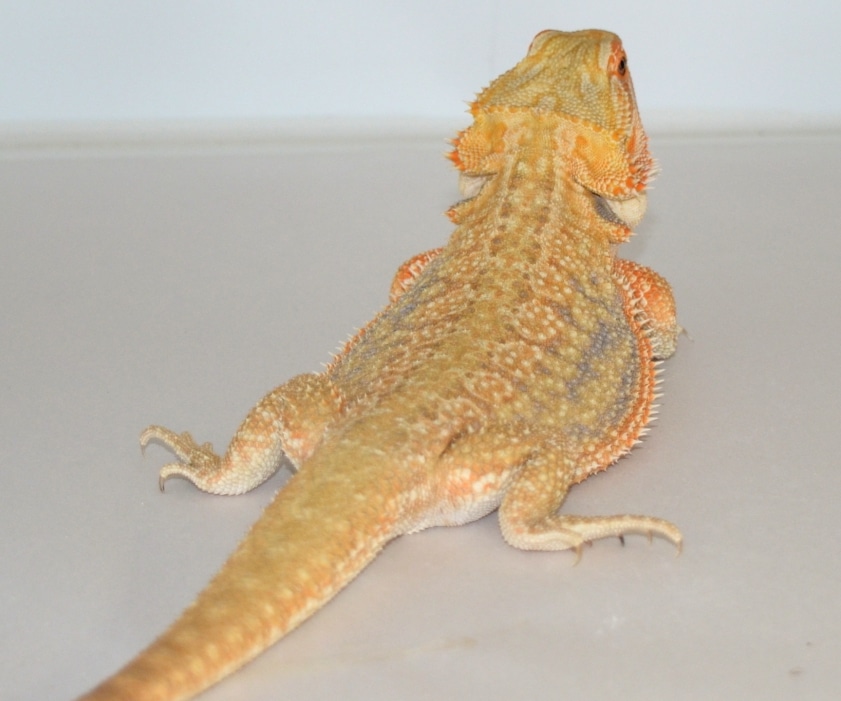
Named after the person who first bred them, Dunners display distinctive markings that set them apart from other morphs. Whereas a typical bearded dragon tends to have very organized stripe patterns in very specific locations on the body, Dunner morphs tend to have disorganized patterning that spans their entire body. This makes them appear to have spots or speckles, rather than stripes.
Sometimes Dunner varieties are solid-colored, though, which can make it more difficult to tell what type of morph they are.
There are some additional features that can be used to identify a Dunner dragon. First, the direction of the scales is different than usual on Dunner varieties. On most beardies, the beard spikes on the neck point downward. On Dunners, these spikes actually point outward to the sides. Elsewhere on a Dunner, the scales may be facing multiple directions. This can cause the scales to look more heavily textured and haphazard compared to the same-direction scales that lay neatly on most other morphs.
Some breeders have noted a peculiar behavior that seems to only be displayed by Dunner varieties. This is to hold food in the back of their throats before swallowing it. For the most part, this does not appear to be harmful or dangerous to the lizard and should not be cause for concern unless the lizard begins to display signs of malnutrition or other health issues.
Some Dunner varieties you might see as you shop around are:
- Hypomelanistic Dunner
- Yellow & Orange Hypo Citrus Dunner
- Hypo Translucent Dunner
- Hypo Translucent Leatherback Dunner
Zero Bearded Dragons
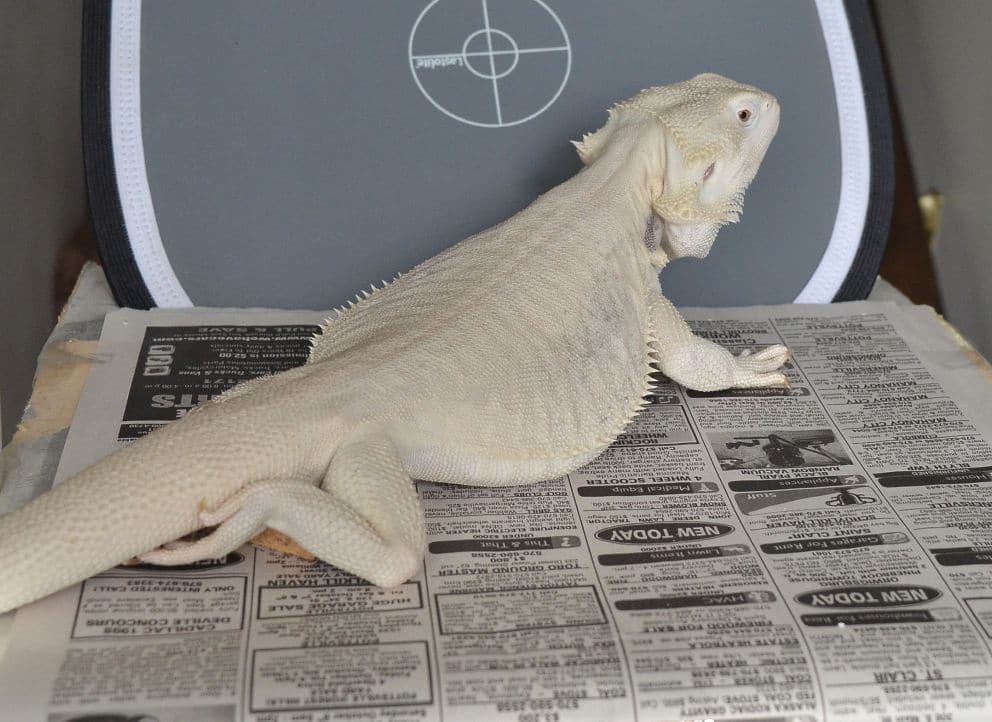
Zero morphs have no colors or patterns (which is the reason behind their name). All patternless morphs, including zeroes, are recessive mutations. The Zero morph is known for its striking appearance, and its silvery white coloring makes it stand out among beardie breeds. Some zeroes are darker grey in color, but may lighten up somewhat when warm. Zero morphs are still fairly rare, and can be quite expensive.
Genetic Stripe Bearded Dragons
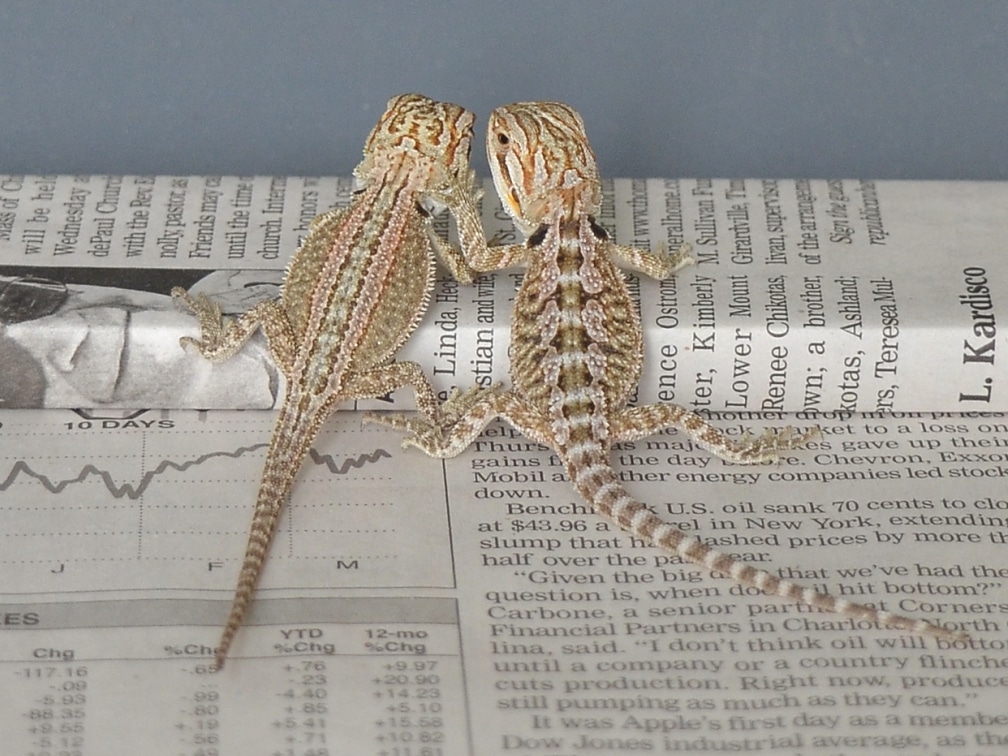
Genetic stripe is a dominant genetic mutation that causes the lizard to display stripes down each side of its spine. The stripes are non-colored, and run at least from neck to tail. The main thing to remember with this morph is that “genetic stripe” is the only striped bearded dragon that is a true morph – or displaying a trait caused strictly by a particular genetic mutation.
While breeders may use the word “stripe” as a descriptive adjective, most striping is caused by a combination of factors rather than a single known mutation like the genetic stripe.
German Giant Bearded Dragons
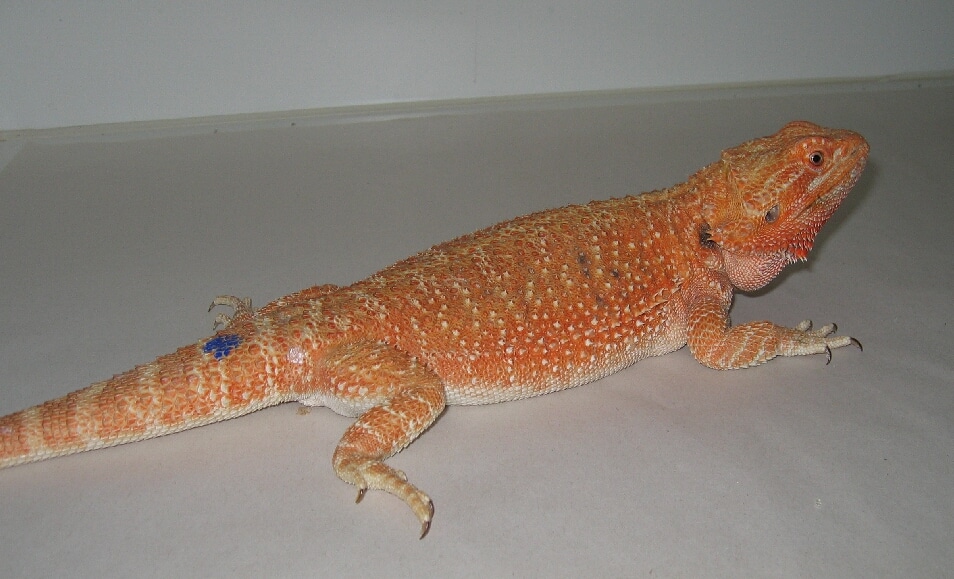
German giants are simply unusually large varieties of classic bearded dragons. It’s difficult to tell if a bearded dragon is actually a giant as a hatchling. In fact, you usually can’t tell until it’s fully grown. If you have a giant bearded dragon, be prepared to provide it with an enclosure large enough to thrive in.
Here are some of the varieties of German Giants you may see on the market:
- Greenie X Orange German Giant
- Hypo Red Dragon German Giant
Witblits Bearded Dragon
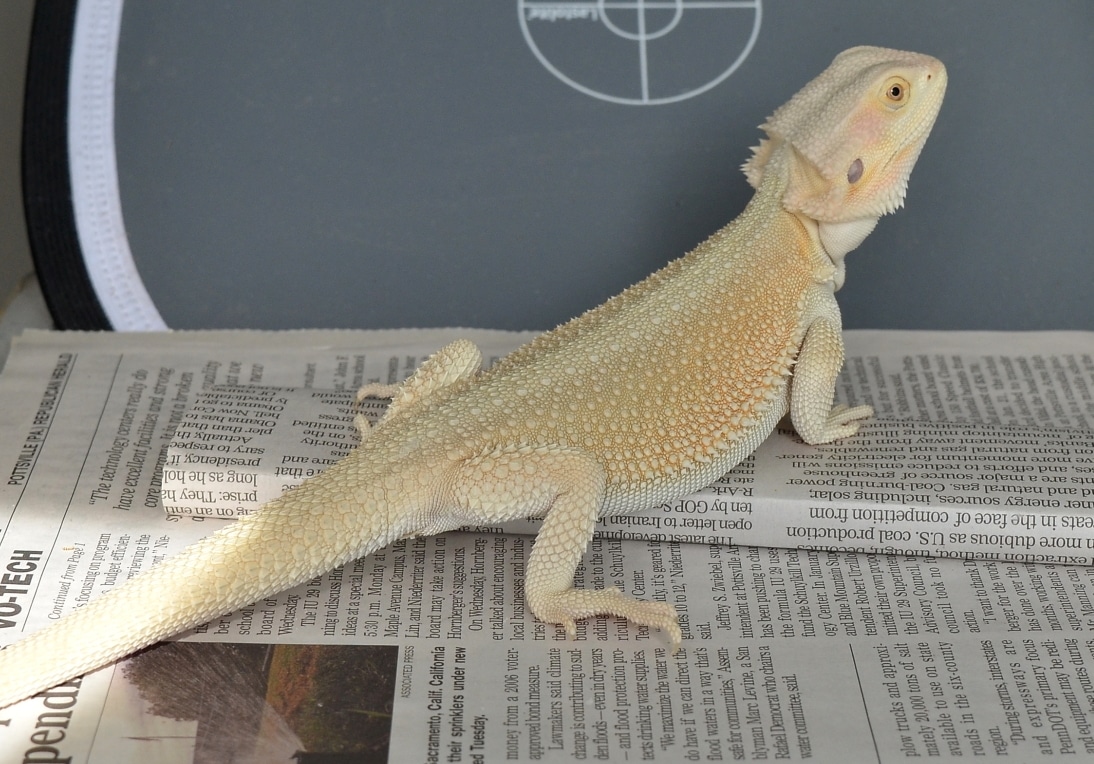
Discovered by a breeder in South Africa, Witblits translates to “white lightning.” However, they are not white. At the time of their discovery, though, they were probably the closest thing to a white beardie that anyone had seen (zeroes were discovered shortly after).
Witblits are patternless, and usually display muted earth tones such as sandy brown and light orange. These rare morphs are usually very expensive to purchase.
Silverback Bearded Dragons
Before the witblits and zero morphs were discovered, Silverbacks were the only patternless bearded dragons available. Silverback morphs are usually off-white, beige, or brownish in color.
They do show patterns as hatchlings, but these slowly fade as they grow older. Silverback morphs are not as popular in the United States as the other patternless varieties, and it’s actually quite rare to find one for sale among breeders here.
This is generally because witblits and zeros produce more desirable traits than silverbacks.
Wero Bearded Dragons

White and patternless, the Wero was created by combining the witblits morph with the zero morph. Weros generally look very similar to zero morphs, but usually display some darker coloring around the tail area.
Paradox Bearded Dragons
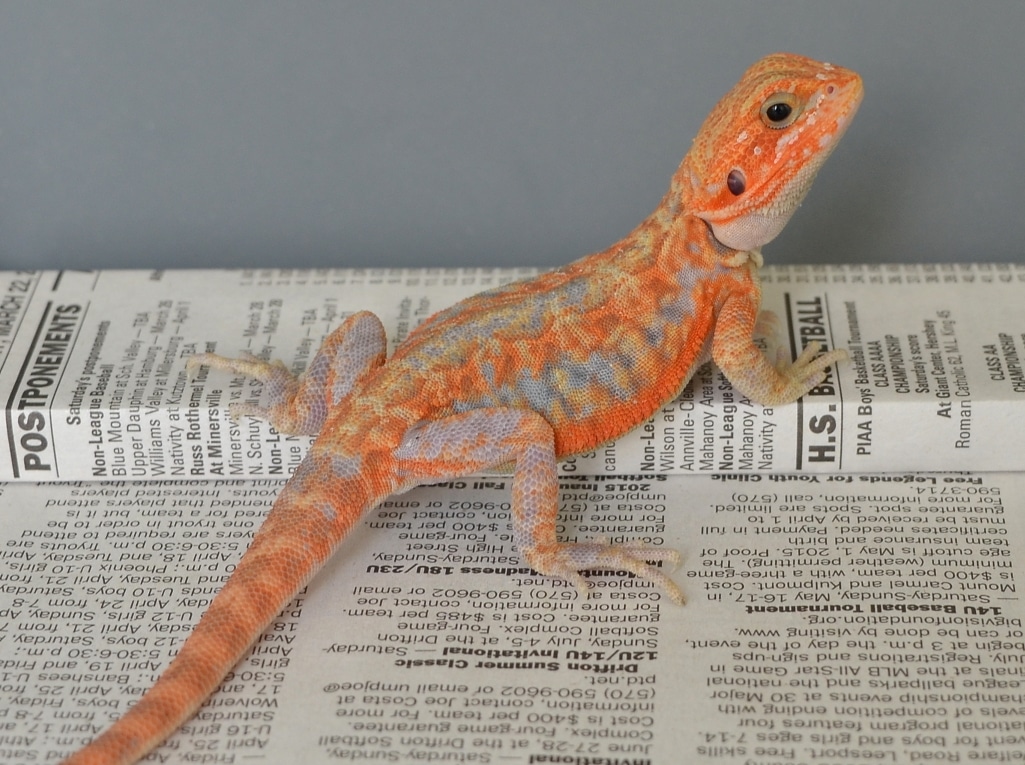
The paradox is easy to distinguish from other varieties due to its striking appearance. Paradox morphs are highly sought after and are prized for their beautiful colors and markings. Part of what sets these beardies apart is the unusual way their markings appear. On a paradox morph, the colors and markings appear random and can often look very artistic!
When breeders are measuring the quality (or value) of a particular paradox beardie, they consider two criteria.
- Color
- Paradox Shifts (or distribution and attractiveness of patterns)
The most highly sought-after paradox specimens show vibrant colors and distinct paradox patches.
The paradox morph is one of the least understood among breeders. This is because the paradox traits come from a variety of genetic mutations. The other morphs discussed in this article are all understood to come from one specific mutation.
Another interesting thing about paradox dragons is that they generally look like any other beardie upon hatching. Only as they begin to mature do they start to display the signature markings associated with the paradox morph.
Finding a Breeder
After you have determined the bearded dragon morph that you would like to buy, the next step in finding a quality breeder.
I highly recommend staying away from large chain pet stores. Generally, their dragons are not well cared for and little work is put into breeding offspring with high quality genetics.
Instead, I recommend looking into well-known breeders that sell their beaded dragons online. We highly recommend Dachiu Dragons – they are a great husband and wife team known around the world for their amazing morphs.
In fact, all of the images above are dragons that they own and breed!
Other Things You Should Know About Bearded Dragon Morphs
The best way to make sure you’re a responsible bearded dragon keeper is to educate yourself as much as possible. Beware of unscrupulous sellers and less-than-reputable breeders. If a breeder is hesitant to answer your questions, find another one. Quality breeders and pet stores will be happy to talk with you patiently and honestly. On the other hand, be wary of anything that seems “too good to be true” (such as a supposedly rare morph being sold for a really low price).
The more you know about bearded dragons and reptile breeding in general, the more difficult it will be for anyone to take advantage of you during a transaction.
- As bearded dragons mature, the patterns and colors they display may change. Their coloring may become duller, or it might become more vivid. Also, patterns may become more or less defined as a lizard grows.
- Bearded dragons can look different in various types of lighting. If you’re purchasing a bearded dragon based on pictures alone, be sure what you see is truly what you’ll be getting. Beardy colors can appear more vibrant in certain lighting. It’s okay to ask a breeder for photos of a lizard in more than one kind of lighting (for example, one under fluorescent lighting, another in natural light). Also, be aware that people may do less-than-honest things to boost sales – like using photoshop or employing overly dramatic editing.
- Breeders often use fun descriptions for the patterns on different bearded dragons. You may see terms like “tiger” or “phantom” used in bearded dragon names. Remember that these are not true morphs, but rather simply adjectives used to help describe the physical characteristics of a lizard (and also to make it sound more interesting to potential buyers).
- “Fancy” is not a morph. Fancy, like the terms discussed previously, is just a word used for informal description. Generally, it’s a blanket term for any morph that’s not the classic variety. It is often used when the breeder or seller is unsure of the exact morph variety but wants to differentiate it from a standard beardie.
- There is no pygmy bearded dragon. Sometimes small beardies are labeled as pygmies. However, there is no true genetic morph that produces small bearded dragons. If you see the word “pygmy” in reference to a bearded dragon, know that it is a descriptive term and does not guarantee a genetic predisposition to being smaller than average.
- Breeding bearded dragons is indeed fascinating, but not something that should be done without expertise. Breeding beardies is not as simple as just placing two opposite-sex specimens in a tank. If you’re interested in becoming a breeder, take time to become educated on all the ins and outs of ethical, responsible breeding. Careless breeding can be cruel and can produce unhealthy animals that may not thrive.
There are no true albino bearded dragons. Some of the pattern-less morphs, particularly the white-colored zero, may be referred to as “albino” when you see them for sale. However, true albinism comes from a total lack of melanin. Albino animals are not only white, they also have red eyes. Some breeders have reported unsuccessful attempts at creating a healthy albino bearded dragon morph. So far there have been no officially documented genetic albinos.
Hey Jeff.
First of all I would like to say what a wonderful article about bearded dragon morphs. I found it very interesting and informative. Thank you.
My only negative view on your article is where you state that “There is no Pigmy Bearded Dragon”. I have only just recently come across your website and do not know much about it or where you are located so please forgive me if you feel as though I am being rude or overstepping any boundaries, but I wanted to tell you that there are infact “pigmy” beardies.
There are about 5 different species of bearded dragon all up. The standard bearded dragon that is most commonly kept in captivity (especially outside of Australia) is the Central Bearded Dragon “Pogona vitticeps” averaging about 45cm in length (nose to tail).
A larger species is the Eastern Bearded Dragon “Pogona barbata” averaging 50cm.
These two can easily be told apart by the Eastern beardie being bright yellow inside it’s mouth opposed to the central’s pink mouth.
The Blacksoil Bearded Dragon, “Pogona henrylawsoni” is on average only 30cm in length and is also commonly known as the Henry Lawson’s Bearded Dragon or the Pigmy Bearded Dragon.
There is also the Mitchell’s Bearded Dragon “Pogona mitchelli” that is on average 32cm in length and could also be commonly called a pigmy.
The last species is the Western Bearded Dragon “Pogona minor”. At an average lenght of 35cm it is slightly larger than the Blacksoil or the Mitchell’s Bearded Dragon but is still substantially smaller than the Central or the Eastern.
So whilst I do agree with your statement that “there is no true genetic morph that produces small bearded dragons”, I do believe that saying “there is no pigmy bearded dragon” is incorrect and misleading.
I hope you receive this well and have the time to reply. I would love to hear your thoughts in regards to the different species of bearded dragons.
Once again I meant no disrespect by contacting you like this and I sincerely apologise if I have upset you in any way.
Sincerely,
Jessica
N.S.W Australia
I’ve been trying to determine which bearded dragon I own for abt 3-4 weeks now. I’ve owned a couple over the last 2 years and I just cannot determine which I have. Any help would be great. Can send pictures. Contact me @ 1(864)344-3590
Loved your article, did not know of morph and delightful to read about it I’m a owner of a 4 month old dragon he is a wonderful pet.
And he inspired me to make habitat for them with things to keep them busy and look more like there own living place.
Hi! Great article! I wondered, if I provide a clear picture of my bearded dragon, if you could help me with a description? I got her from a chain pet store & they were unable to give me a single bit of info regarding age, morph, breeder, ect… I feel like I’ve finally got the important stuff re: care & habitat, so now I’m just curious about color, morph. I *think* maybe she’s a citrus tiger leatherback.